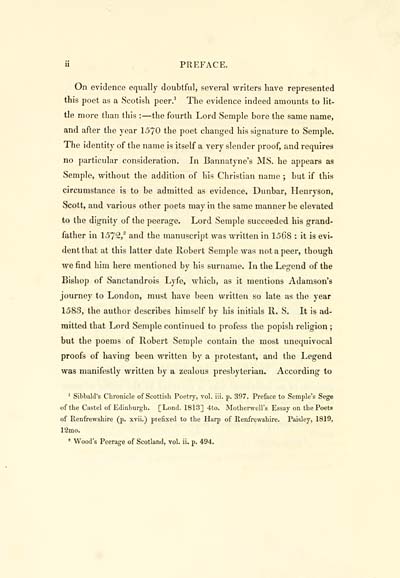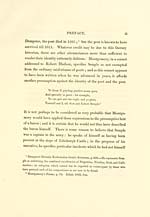Bannatyne Club > Philotus
(24) Page ii
Download files
Complete book:
Individual page:
Thumbnail gallery: Grid view | List view

u PREFACE.
On evidence equally doubtful, several writers have represented
this poet as a Scotish peer.' The evidence indeed amounts to lit-
tle more than this : — the fourth Lord Semple bore the same name,
and after the year 1570 the poet changed his signature to Semple.
The identity of the name is itself a very slender proof, and requires
no particular consideration. In Bannatyne's MS. he appears as
Semple, without the addition of his Christian name ; but if this
circumstance is to be admitted as evidence, Dunbar, Henryson,
Scott, and various other poets may in the same manner be elevated
to the dignity of the peerage. Lord Semple succeeded his grand-
father in 1572,^ and the manuscript was written in 1568 : it is evi-
dent that at this latter date Robert Semple was not a peer, though
we find him here mentioned by his surname. Li the Legend of the
Bishop of Sanctandrois Lyfe, which, as it mentions Adamson's
journey to London, must have been written so late as the year
1583, the author describes himself by his initials R. S. It is ad-
mitted that Lord Semple continued to profess the popish religion ;
but the poems of Robert Semple contain the most imequivocal
proofs of having been written by a protestant, and the Legend
was manifestly written by a zealous presbyterian. According to
' Sibbald's Chronicle of Scottish Poetry, vol. iii. p. 397. Preface to Semple's Sege
of the Castel of Edinburgh. [Lond. 1813] 4to. Motherwell's Essay on the Poets
of Renfrewshire (p. xvii.) prefixed to the Harp of Renfrewshire. Paisley, 1819,
12mo.
' Wood's Peerage of Scotland, vol. ii. p. 494.
On evidence equally doubtful, several writers have represented
this poet as a Scotish peer.' The evidence indeed amounts to lit-
tle more than this : — the fourth Lord Semple bore the same name,
and after the year 1570 the poet changed his signature to Semple.
The identity of the name is itself a very slender proof, and requires
no particular consideration. In Bannatyne's MS. he appears as
Semple, without the addition of his Christian name ; but if this
circumstance is to be admitted as evidence, Dunbar, Henryson,
Scott, and various other poets may in the same manner be elevated
to the dignity of the peerage. Lord Semple succeeded his grand-
father in 1572,^ and the manuscript was written in 1568 : it is evi-
dent that at this latter date Robert Semple was not a peer, though
we find him here mentioned by his surname. Li the Legend of the
Bishop of Sanctandrois Lyfe, which, as it mentions Adamson's
journey to London, must have been written so late as the year
1583, the author describes himself by his initials R. S. It is ad-
mitted that Lord Semple continued to profess the popish religion ;
but the poems of Robert Semple contain the most imequivocal
proofs of having been written by a protestant, and the Legend
was manifestly written by a zealous presbyterian. According to
' Sibbald's Chronicle of Scottish Poetry, vol. iii. p. 397. Preface to Semple's Sege
of the Castel of Edinburgh. [Lond. 1813] 4to. Motherwell's Essay on the Poets
of Renfrewshire (p. xvii.) prefixed to the Harp of Renfrewshire. Paisley, 1819,
12mo.
' Wood's Peerage of Scotland, vol. ii. p. 494.
Set display mode to: Large image | Transcription
Images and transcriptions on this page, including medium image downloads, may be used under the Creative Commons Attribution 4.0 International Licence unless otherwise stated. ![]()
| Publications by Scottish clubs > Bannatyne Club > Philotus > (24) Page ii |
|---|
| Permanent URL | https://digital.nls.uk/81161022 |
|---|
| Description | Place of publication Edinburgh unless otherwise stated. No. 125 is relative to but not part of the club's series. |
|---|---|
![[Page i]Preface](https://deriv.nls.uk/dcn4/8116/81161012.4.jpg)
